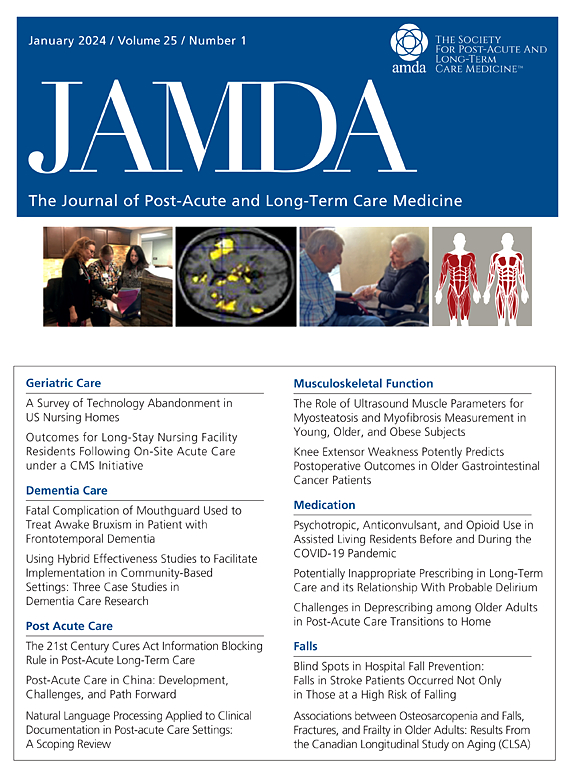Risk Factors for Falls in Community-Dwelling Older Adults: An Umbrella Review
IF 4.2
2区 医学
Q2 GERIATRICS & GERONTOLOGY
Journal of the American Medical Directors Association
Pub Date : 2025-07-26
DOI:10.1016/j.jamda.2025.105765
引用次数: 0
Abstract
Objectives
Falls are a key public health concern, resulting in disability and increased mortality risk. An extensive body of literature has examined risk factors for falls; however, results vary across different studies and populations. We aimed to synthesize systematic reviews of fall risk factors in community-dwelling older adults.
Design
A systematic review of systematic reviews. Searches were executed in 6 databases (MEDLINE, Embase, CINAHL, Cochrane Library, PsychINFO, and AgeLine) from inception until June 13, 2023.
Setting and Participants
Eligible studies included systematic reviews of prospective cohort studies that included a population of community-dwelling older adults (≥60 years of age) and reported fall risk factors.
Methods
Three reviewers screened 8173 records. Summary data were extracted, and the units of analyses were the relationships between risk factors and falls. Descriptive results are reported in counts and frequencies.
Results
Fifty-seven reviews were included examining 29 risk factors. Mobility-related measures (balance, gait, physical function, physical activity, dual task ability, strength, and range of motion) accounted for 40% of all relationships. Clinical tests of balance and physical function, cognition, specifically executive function (76% significant) and processing speed (100%), medications (58%), frailty (100%), and chronic conditions (83%) were all consistent predictors of falls. There was a paucity of evidence for psychosocial, environmental, and sociodemographic factors. Most reviews (54%) were rated as low risk of bias.
Conclusions and Implications
Mobility-related risk factors for falls are well established and can be addressed through interventions. Findings highlight the limited examination of psychosocial, sociodemographic, and environmental risk factors for falls, indicating areas for future research.
社区居住老年人跌倒的危险因素:一项综述。
目标:跌倒是一个重要的公共卫生问题,导致残疾并增加死亡风险。大量文献研究了跌倒的危险因素;然而,结果在不同的研究和人群中有所不同。我们的目的是综合对社区居住老年人跌倒危险因素的系统评价。设计:系统回顾的系统回顾。从成立到2023年6月13日,在6个数据库(MEDLINE, Embase, CINAHL, Cochrane Library, PsychINFO和AgeLine)中进行了检索。环境和参与者:符合条件的研究包括前瞻性队列研究的系统评价,包括社区居住的老年人(≥60岁)和报告的跌倒危险因素。方法:3名审稿人筛选8173份记录。提取汇总数据,分析单元为危险因素与跌倒之间的关系。描述性结果以计数和频率报告。结果:纳入了57篇综述,检查了29个危险因素。与活动相关的测量(平衡、步态、身体功能、身体活动、双重任务能力、力量和活动范围)占所有关系的40%。平衡和身体功能的临床测试,认知,特别是执行功能(76%)和处理速度(100%),药物(58%),虚弱(100%)和慢性疾病(83%)都是跌倒的一致预测因素。缺乏关于心理社会、环境和社会人口因素的证据。大多数评价(54%)被评为低偏倚风险。结论和意义:与活动相关的跌倒危险因素已经确定,可以通过干预措施加以解决。研究结果强调了对跌倒的社会心理、社会人口和环境风险因素的有限检查,指出了未来研究的领域。
本文章由计算机程序翻译,如有差异,请以英文原文为准。
求助全文
约1分钟内获得全文
求助全文
来源期刊
CiteScore
11.10
自引率
6.60%
发文量
472
审稿时长
44 days
期刊介绍:
JAMDA, the official journal of AMDA - The Society for Post-Acute and Long-Term Care Medicine, is a leading peer-reviewed publication that offers practical information and research geared towards healthcare professionals in the post-acute and long-term care fields. It is also a valuable resource for policy-makers, organizational leaders, educators, and advocates.
The journal provides essential information for various healthcare professionals such as medical directors, attending physicians, nurses, consultant pharmacists, geriatric psychiatrists, nurse practitioners, physician assistants, physical and occupational therapists, social workers, and others involved in providing, overseeing, and promoting quality

 求助内容:
求助内容: 应助结果提醒方式:
应助结果提醒方式:


